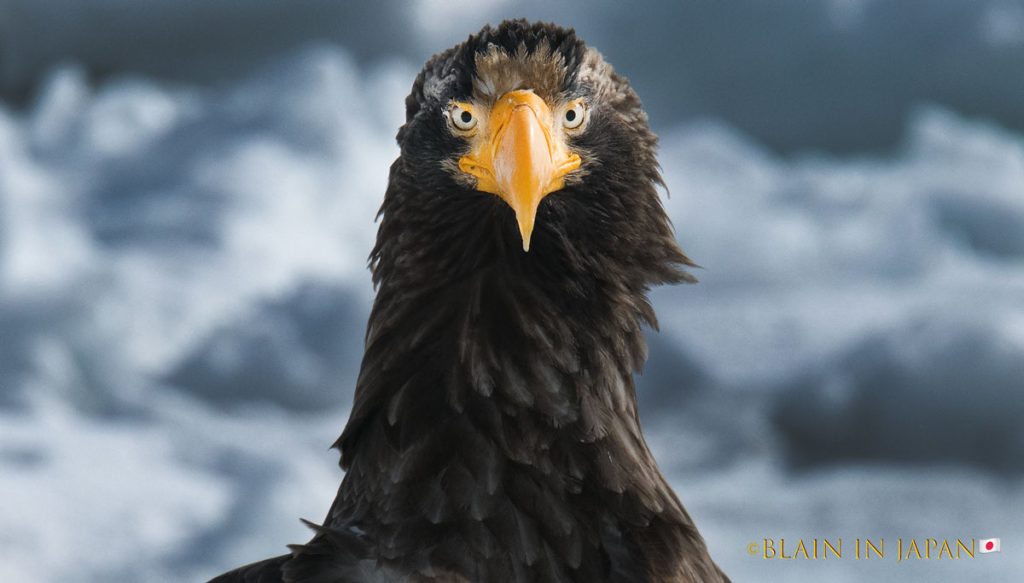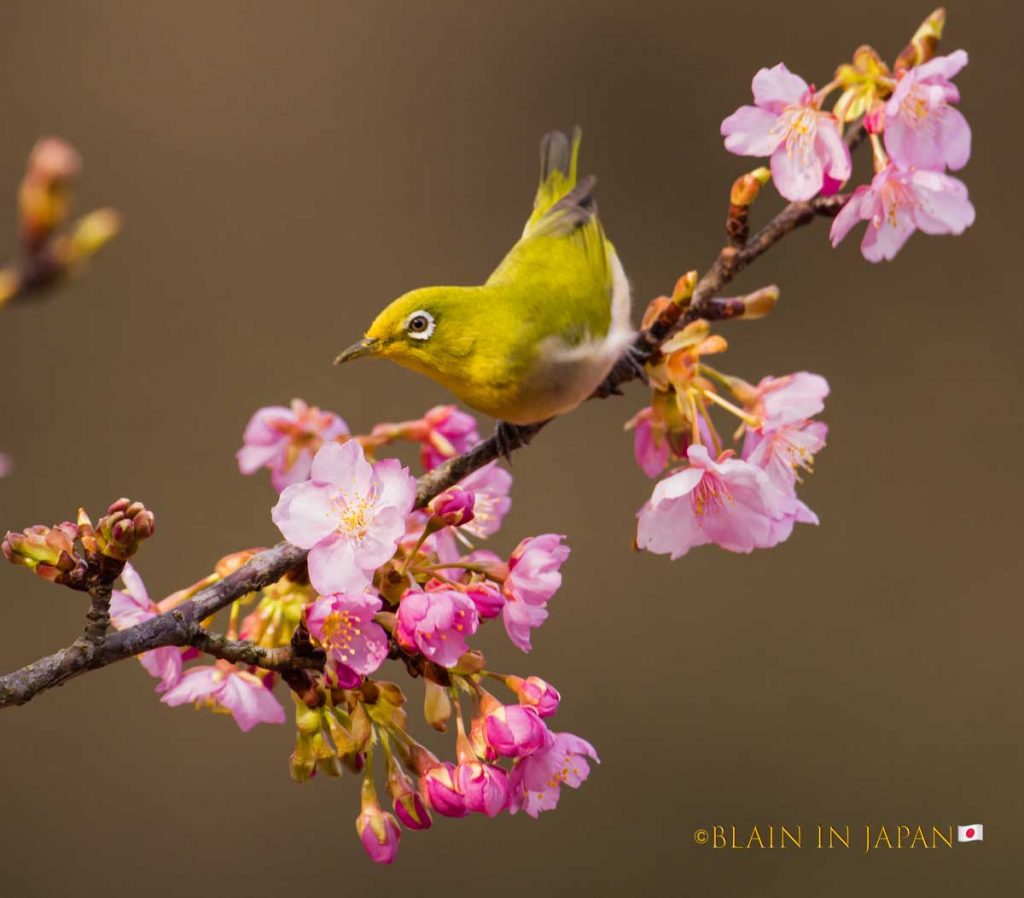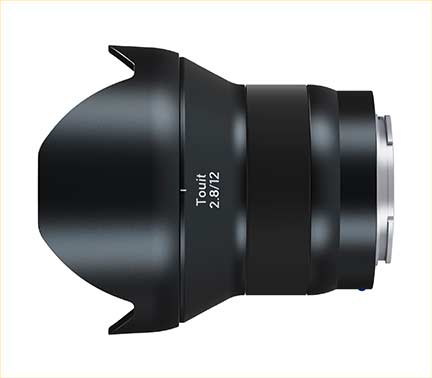
Introduction
When the Dutch representative of the Zeiss lenses asked me whether I am interested in testing the Zeiss Touit 12mm lens, I immediately agreed. Zeiss is a legendary name in lens design and I was interested to see the first models of the new line of autofocus lenses for the Fujifilm X series and Sony Alpha NEX mirrorless system cameras.
Most of the reviews that I have seen so far focused on the general characteristics of the lens, such as build quality, resolution, distortion, etc. These characteristics are of course very important to consider before one decides to buy a lens. However, what I was missing in the reports was the discussions on specific use-cases of ultra wide angle lenses, and how this Zeiss lens performs for these use-cases (for example, architecture, nighttime cityscape and landscape photography).
Hence, the goal of this article is to give some impressions about the performance and handling of this lens from the point of view of these uses-cases. I will, of course, write about the general characteristics of the lens too, but this will not be extensive.
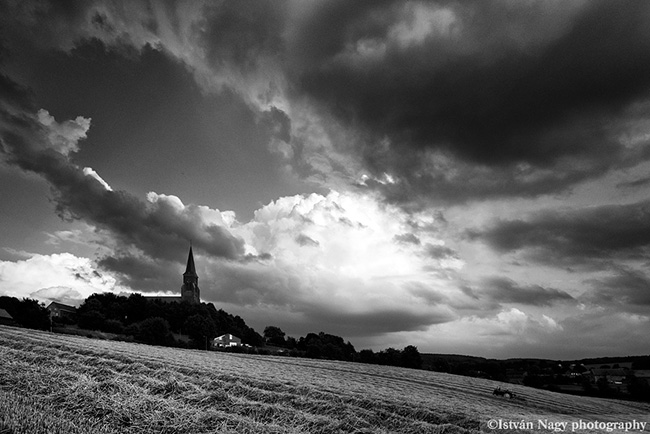
Heuvelland. Vijlen, The Netherlands
Fuji X-E1 with Zeiss Touit 12mm lens
Unboxing: Outlook, Build Quality and Ergonomics
There is nothing more rewarding after a long a working day than having a nice dinner and sipping a freshly opened cold bottle of Belgian beer on a summer evening in your backyard here, in the Netherlands. Well this is almost true. There are actually exceptions: when you arrive home and find a freshly delivered package containing a Zeiss lens waiting to be opened. Immediately. Just be sure to warn your spouse beforehand that you are expecting a “very important” package. You will skip dinner and cease to be a social being for a couple of hours.
Opening up the box reveals an aesthetically very appealing lens with a design lens hood. The smooth, clean curves of the lens barrel and lens hood certainly makes the lens dressed to impress. The lens hood is actually designed in a way that it looks as a natural extension of the lens barrel. The lens is relatively big (270g, 86x65mm) compared to other Fujinon and Voigtlander lenses I have seen and used. However, the lens turned out to be a nice fit for the X-E1 body. The build quality is top-notch and Zeiss clearly used premium materials. The lens hood can be attached backwards, which is very handy if you want to carry the lens with the camera in a small shoulder bag.
The ergonomics of the lens is in general good. I have noticed only one minor thing for improvement. Both the aperture and focus rings are embedded in the body of the lens and they are made of the same rubber with the same texture. This makes it difficult to distinguish the two rings just by touch. Fujifilm prevents this problem on their lenses by consistently making the textures different. The rubber material of the rings on the Zeiss lens gives good tactile feeling I just wish the rings would stick a bit more out of the body to find them easily.
First Challenge: Nighttime Cityscape and Architecture Photography
Nighttime cityscapes are often considered the most challenging subjects – the ultimate test – for ultra wide angle lenses. A cityscape at night is typically full of artificial light sources of different types. If you combine these bright light sources with the ruling low light condition then the result is a beautiful high contrast scenery with rich, saturated colors. Ultra wide angle lens need to be very well designed to give excellent image quality under these non-ideal light conditions. Lens flare or loss of contrast due to stray light are typical examples of undesired artifacts that we prefer not to have (with some exceptions) in the final picture. Due to the strong presence of the lines of building and roads, any distortion can also be distracting, especially if the lines are close to the edge of the picture.
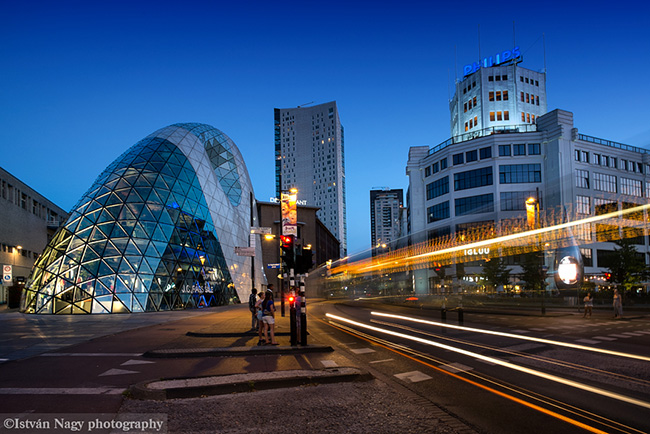
Nighttime Cityscape. Eindhoven, The Netherlands
Fuji X-E1 with Zeiss Touit 12mm lens, f/8.0 – 1.7 sec
The lens (and lens hood) performed very well, with no notable flare or loss of contrast. Autofocus (AF) also performed well under these light conditions too. The AF speed is comparable with the AF speed of the Fujinon XF 18mm f/2 lens – the 18mm lens seems to be a bit faster. In general, AF was quick enough in this session and I did not experience focus hunting at all.
Distortion wise, I was also content with the lens. The optical distortion of the lens is circa 2-2.5%. This is digitally always automatically corrected in Lightroom based on correction data stored directly in raw files, hence, leading to 0.1% distortion as written in the data sheet of the lens. If you want to see the uncorrected raw image, I recommend to open it up in Capture One and disable distortion correction.
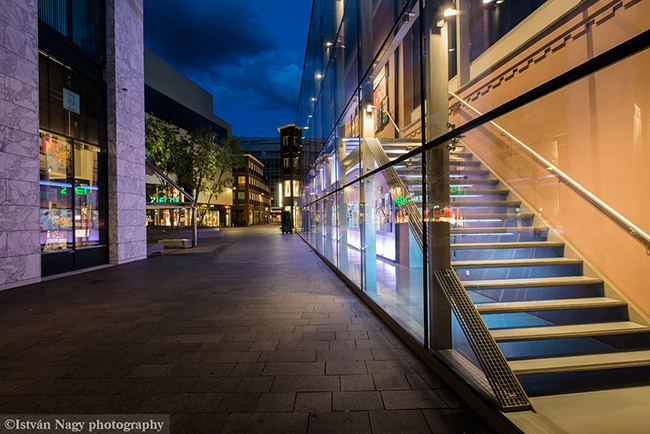
Philips Museum. Eindhoven, The Netherlands
Fuji X-E1 with Zeiss Touit 12mm lens, f/8 3.2 sec
Personally, I am not against digital correction – that is, applying image processing algorithms after exposure that will shift pixels to compensate for this effect – as long as it does not lead to substantial loss of resolution. Looking at the corner resolution of the lens, the engineers at Zeiss did their homework well. We will come back to lens sharpness below.
Second Challenge: Panoramic Photography
The next use case for the lens was about taking a stitched panorama picture. The Zeiss Touit 12mm lens has a horizontal field of view of 89 degree – it is already wide enough to take “single shot panoramas” with cropping applied. Nevertheless, I wanted to see how well the lens stood up in stitched panoramas that covered more than 89 degrees.
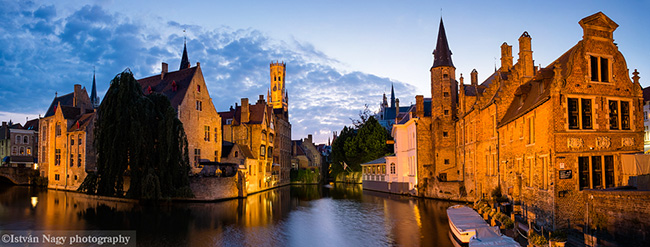
Rozenhoed quay. Bruges, Belgium
Fuji X-E1 with Zeiss Touit 12mm lens
The location of the picture this time was the city of Bruges in Belgium – it is often designated as the “Venice of the North” in Europe: it is charming city crisscrossed by canals between 17th century architectures. I was visiting Bruges for the second time and I knew that the Rozenhoed quay – well, definitely not the most original shooting location – has a beautiful panoramic view. The place has a fame among the regular tourist so it was not easy to find a good spot for my tripod. Fortunately, while I was checking one of the potential spots, a young couple spotted me and the girl in the couple made me an offer that I gladly accepted: ‘if you take a capture about us with this background, you can place your tripod here’. My short reply was ‘Deal!’ with a big smile on my face. On a side note, I have been asked by three more couples to take similar pictures about them during the same night. The Fuji X-series is considered discrete enough for street photography, so either the Gitzo tripod or my lengthy preparations were signalingphotographer at work.
Ultra wide angle lenses are in general not the most preferred lenses for panoramic photography that involves stitching for a number of reasons: vignetting, possible distortion and weak corner sharpness make the stitching process difficult. As a result, the stitching process often lead to images with poor resolution and/or visible stitching artifacts. However, the result of the stitching of these pictures was nothing short but excellent. The chromatic aberration seemed to be high for some reason (the lens was stopped down to f/8); however, this was easy to correct in LR. All in all, the stitching process resulted in a panoramic picture without any signs of stitching or quality degradation. Edge to edge sharpness is a reality with this lens stopped down to f/8 – the resulting image has a beautiful, homogeneous sharpness across the whole frame.
Third Challenge: Close Ups and Bokeh
Since the lens has the focal length of 12mm, the hyperfocal distance of the lens is very short: approximately 2.4m at f/2.8 and 0.9m at f/8. This means that it is very easy to take pictures with infinite depth of field with this lens. With such lens characteristics, it may seem to be an unorthodox idea to use a 12mm lens for close up shoots that provide shallow depth of fields. The first real close-up pictures made me realize very quickly that shooting pictures with beautiful bokeh is in fact very feasible with this lens. The lens produces very good quality bokeh (for what you can get on an APS-C sized sensor), its softness is somewhere between the “punchy” bokeh of the 18mm Fujinon and the “creamy” style of the 35mm Fujinon. The combination of the wide angle perspective with this style of bokeh can create a unique picture style that will likely inspire many photographers who use this lens.
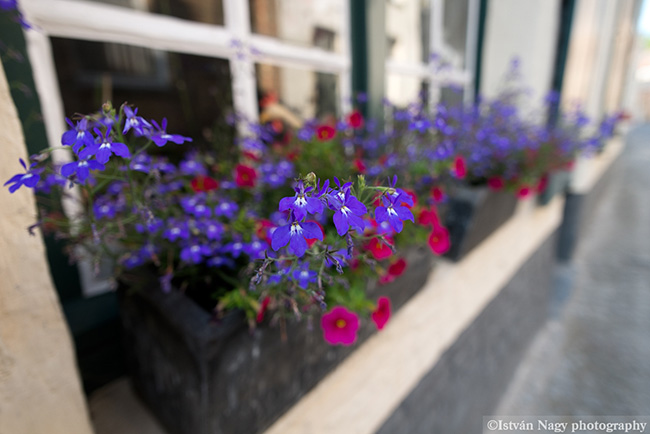
Flowers on Window Sill. Bruges, Belgium
Fuji X-E1 with Zeiss Touit 12mm lens, f/2.8 – 1/320
Naturally, I wanted to use f/2.8 for the optimal smoothness in the bokeh; however, the resolution provided by the lens wide open, as expected, was also slightly less compared to stopping down the lens to f/5.6. I have not done any resolution measurement with this lens – I leave this up to professional labs who can do these measurements much better – but the difference was visible in the sharpness between the f/2.8 and f/5.6 versions of the same capture on the screen.
The focus-by-wire manual focus was easy and convenient to use on the lens. In combination with the focus peaking feature of the X-E1, the accuracy and speed of focusing was good. The rubberized focusing ring had a good tactile feeling and it was easy to make fine adjustments. The lack of a depth of field and distance scales are likely going to be tough for many landscape and street photographers. The former will need to turn on the distance scale in the EVF (which will mask the edge of the composed picture) to check whether the current focus is at hyperfocal distance, while the latter will need to look into the viewfinder first in case they would like to do zone focusing. The Fujinon 14mm f/2.8 lens for the X-series cameras has clearly an advantage in this area with having both distance and depth of field scales.
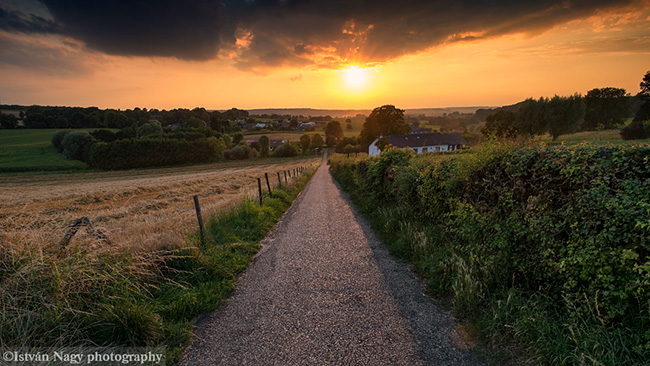
Heuvelland Sunset. South-Limburg, The Netherlands
Fuji X-E1 with Zeiss Touit 12mm lens, f/11 – 1/55
The Bottom Line
It is not for nothing Zeiss is legendary for their lenses. Zeiss lenses are recognized for their outstanding optical and build quality – the Zeiss Touit 12mm lens is no exception either. The lens provided excellent image quality – especially considering its sharpness, contrast and definition of color – in all use-cases during the field test. All in all, it is an impressive lens that will certainly inspire many photographers with a creative heart and mind.
I have noticed only minor issues with the lens during the test period: the lack of distance and depth of field scales, the non-differentiable rings might be not important for many of us. However, the lack of scales can be showstoppers for those who wants to “shoot from the hip” or prefers to operate the camera without switching between the view modes of the EVF.
The Zeiss Touit 12mm lens provides a horizontal field of view of almost 90 degree. This angle of view often requires some creativity and getting close to your subject is important to avoid technically interesting pictures with non-interesting content. Hence, be prepared that this ultra wide angle lens will put you out of your comfort zone when you need to get close and personal to your subject. However, the results are well worth for it.
Istvá n Nagy
November, 2013
About
Istv á n Nagy was born in 1977 in Karcag, Hungary. Istv á n holds a Master’s degree from University of Debrecen, Hungary and a PhD degree in Computer Science from University of Twente, the Netherlands. Since 2006, he works as a scientist / architect – with an unscientific artistic streak – in a large high-tech company headquartered in the Netherlands. As an autodidact photographer, he specializes in fine-art landscape and panoramic photography. In his photographic prints – characterized by compositions with simplicity and balance – he aims to capture and convey the many moods of near and distant sceneries, be that raw, dramatic, peaceful or just simply beautiful. He works with Canon 5D mark2, Rolleiflex 2.8F, Fujifilm X-E1 cameras and natural light. Istv á n lives in Eindhoven with his partner, Nicole and his son, Daniël
You can find more information about Istv á n ‘s work at his website. He can be reached byemail and Facebook
Read this story and all the best stories on The Luminous Landscape
The author has made this story available to Luminous Landscape members only. Upgrade to get instant access to this story and other benefits available only to members.
Why choose us?
Luminous-Landscape is a membership site. Our website contains over 5300 articles on almost every topic, camera, lens and printer you can imagine. Our membership model is simple, just $2 a month ($24.00 USD a year). This $24 gains you access to a wealth of information including all our past and future video tutorials on such topics as Lightroom, Capture One, Printing, file management and dozens of interviews and travel videos.
- New Articles every few days
- All original content found nowhere else on the web
- No Pop Up Google Sense ads – Our advertisers are photo related
- Download/stream video to any device
- NEW videos monthly
- Top well-known photographer contributors
- Posts from industry leaders
- Speciality Photography Workshops
- Mobile device scalable
- Exclusive video interviews
- Special vendor offers for members
- Hands On Product reviews
- FREE – User Forum. One of the most read user forums on the internet
- Access to our community Buy and Sell pages; for members only.





